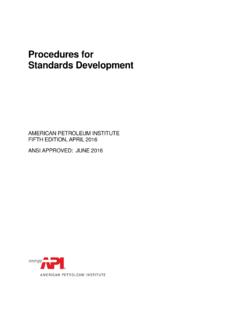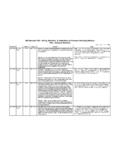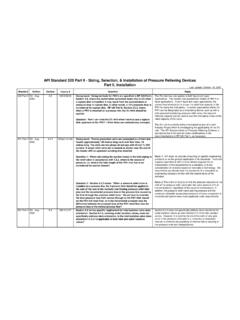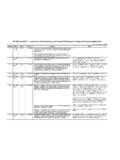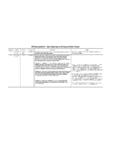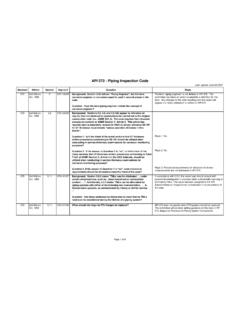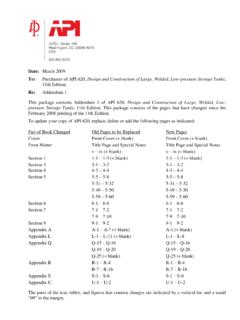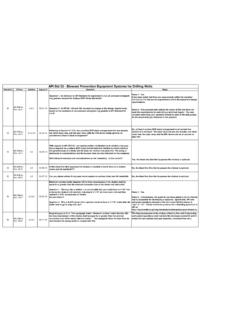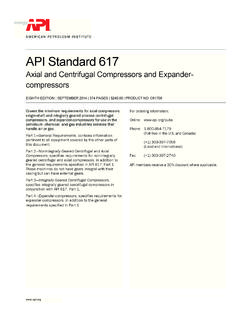Transcription of API Standard 617 - Axial and Centrifugal and Expander ...
1 Last update: November 23, 2010 StandardEditionSectionInquiry #QuestionReply6177th - Jul. 2002 Chapt. 1 & the 7th edition of API 617, the Standard has been divided into chapters, for a Centrifugal compressor, is the intent that Chapter 2 applies, and Chapter 1 would apply only when referenced by Chapter 2? Or does Chapter 1 apply, and Chapter 2 modifies Chapter 1 if paragraph number is used in Chapter 2?Please refer to Chapter 1, Clause , which states This chapter contains information pertinent to all equipment covered by this Standard . It is to be used in conjunction with the following chapters as applicable to the specific equipment 2 Centrifugal and Axial CompressorsChapter 3 Integrally Geared CompressorsChapter 4 Expander -compressors for the basic use of the the Centrifugal Compressor example cited, BOTH Chapters 1 and Chapter 2 would apply.
2 ( Information in Chapters 2,3,and 4 are in addition to the common information contained in Chapter 1.)6177th - Jul. 2002 Chapt. 1: Clause mentions that equipment shall be designed and constructed for a minimum service life of 20 years and at least five years of uninterrupted operation . What does API mean by five years of uninterrupted operation? Question 2: How do you quantify this five-year requirement? Question 3: The sixth edition required only three years of uninterrupted operation. What does this change signify?Reply 1: It is the intent of API 611 to provide equipment (including auxiliaries) that has been designed to provide five years of uninterrupted operation without scheduled maintenance that would require shutdown.
3 Reply 2: See Reply 3: API does not does not provide the rationale behind requirements in its standards . These requirements are based upon consideration of technical data and the judgment and skill of experienced engineering and technical personnel representing both users and manufacturers who serve on the standards -writing committees. All technical meetings during which API requirements are considered are open to the public. The API Subcommittee on Mechanical Equipment meets twice per year at the Spring and Fall Refining Meetings. Information on these meetings can be found on the API website at - Jul.
4 2002 Chapt. appears that the electrical runout is lower for metric units than for the US customary units in of Chapter 1. Is this correct? The allowable limits for electrical runout were established as a percentage of allowable vibration in Customary Units. In this case, 25% of 1 mil or mil. Rounding during soft conversion to metric units has introduced a significant difference. We agree that a hard conversion should have been made in this instance. A correction to m in metric units will be considered for the next Standard 617 - Axial and Centrifugal and Expander -compressors for Petroleum,Chemical and Gas Industry ServicesLast update: November 23, 2010 StandardEditionSectionInquiry #QuestionReplyAPI Standard 617 - Axial and Centrifugal and Expander -compressors for Petroleum,Chemical and Gas Industry Services6177th - Jul.
5 2002 Chapt. : A compressor was sold under the specification of API 617. No other requirements or exceptions have been defined. The analytical rotordynamic study shows a critical speed within the operating speed range. The amplification factor of this critical is calculated to be AF= (clearly below , assuming the unbalance response verification test is confirming an AF clearly below ).Question: What is the required separation margin for a critical speed with an amplification factor (AF) of less than separation margin is not required for a critical speed with an AF less than - Jul. 2002 Chapt. to , the correction factor calculated per Equation shall have a value greater than Is the value meant to be the lower correction factor to be used for calculating the unbalance response amplitudes to assess the minimum design running clearances, or it is a more stringent requirement to limit the vibration amplitude at probes location?
6 This factor is used during the analytical calculation procedure. Analytically, amplitude should have a linear relationship to unbalance weight. Rather than requiring the designer to re-run the program with a different unbalance weight in order to match required vibration amplitude, the API Standard allows linear interpolation to be used. The only purpose of the correction factor is to limit the amount of linear interpolation to reasonable levels. This factor is then used in paragraph to confirm analytical conformance to the minimum design diametrical clearance - Jul. 2002 Chapt. : The definition and requirement of the speeds is sometimes subject to discussion with vendor and/or client when performance test result requires the increased speed because interpretation of the requirement is different.
7 When the maximum continuous speed (MCS) is set at 105% to comply with the minimum requirement defined by (Chapter 1, Clause ), and the impeller overspeed test has been done at 115% of MCS to comply with minimum requirement specified in (Chapter 1, ), if increased speed adjustment is required as a result of the performance test tolerances, the speed of impeller overspeed test will no longer comply with the speed requirement of Chapter 1, Clause : If increased speed adjustment is required as a result of the performance test tolerance, does the Standard still require the spin speed margin of 115% during overspeed testing?
8 Clause of Chapter 1 requires an overspeed at no less than 115% of maximum continuous speed. If maximum continuous speed is adjusted as a result of a performance test, this criteria still - Jul. 2002 Chapt. to Chapter 1, Section , should a compressor mechanical test be re-run after correction of a mechanical deficiency with the assembly?Yes, the requirement to re-run the final shop tests includes modifications to the assembly to correct update: November 23, 2010 StandardEditionSectionInquiry #QuestionReplyAPI Standard 617 - Axial and Centrifugal and Expander -compressors for Petroleum,Chemical and Gas Industry Services6177th - Jul.
9 2002 Chapt. 2617-I-01/03 Question 1: Is the intention of Chapter 2 to cover compressors with overhung impellers (with or without external gear unit) or is it only restricted to beam type rotors? Our interpretation is that it only applies to beam type rotors, since the typical construction drawing at Annexure 2C does not show a typical compressor with overhung impeller type construction. Advise whether or not our interpretation is 2: If overhung impeller construction (with or without external gear unit) is not covered by Chapter 2, can this be considered a sub-set of Chapter 3? Question 3: If overhung impeller construction (with or without external gear unit) is a sub set of Chapter 3, we consider that such service can not be applied to pipeline compression service - since of Chapter 3 does not list such a service.
10 Advise whether or not our interpretation is 1: Chapter 2 Centrifugal and Axial Compressors covers overhung impeller Centrifugal compressors (with or without external gears) in the text of the document. The illustration was inadvertently omitted. Reply 2: See Reply 3: Since the overhung impeller compressor is covered by Chapter 2, pipeline service is - Jul. 2002 Chapt. 2, Clause , requires stub-shafts to meet all quality and heat treatment criteria for shaft forgings when modular (through-bolt) rotors are provided. Does this clause apply to Centrifugal compressors? - Jul. 2002 Chapt. 2 Section 5617-I-03/03 Please provide a clarification of Page 1 of the Centrifugal and Axial Compressor Data Sheet, Lines 31 and 32.
